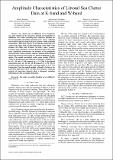Files in this item
Amplitude characteristics of littoral sea clutter data at K-band and W-band
Item metadata
| dc.contributor.author | Rahman, Samiur | |
| dc.contributor.author | Vattulainen, Aleksanteri | |
| dc.contributor.author | Robertson, Duncan A. | |
| dc.date.accessioned | 2022-05-27T15:30:10Z | |
| dc.date.available | 2022-05-27T15:30:10Z | |
| dc.date.issued | 2022-03-21 | |
| dc.identifier | 276023475 | |
| dc.identifier | 80acd17b-e0da-4f9c-9b4c-b44367d1c7e4 | |
| dc.identifier | 000821555200119 | |
| dc.identifier | 85146198193 | |
| dc.identifier.citation | Rahman , S , Vattulainen , A & Robertson , D A 2022 , Amplitude characteristics of littoral sea clutter data at K-band and W-band . in 2022 IEEE radar conference proceedings . , 9764262 , Proceedings of the IEEE radar conference , IEEE , Piscataway, NJ , 2022 IEEE Radar Conference (RadarConf'22) , New York , New York , United States , 21/03/22 . https://doi.org/10.1109/radarconf2248738.2022.9764262 | en |
| dc.identifier.citation | conference | en |
| dc.identifier.isbn | 9781728153681 | |
| dc.identifier.isbn | 9781728153698 | |
| dc.identifier.issn | 1097-5764 | |
| dc.identifier.other | ORCID: /0000-0002-4042-2772/work/113060882 | |
| dc.identifier.other | ORCID: /0000-0002-5477-4218/work/113061064 | |
| dc.identifier.other | ORCID: /0000-0003-1898-600X/work/120432946 | |
| dc.identifier.uri | https://hdl.handle.net/10023/25456 | |
| dc.description | Funding: UK Engineering and Physical Sciences Research Council under grant EP/S032851/1. | en |
| dc.description.abstract | Sea clutter data at millimeter wave frequencies are quite limited in the literature. Recent advancements in millimeter wave radar technology have created a potential for its use in maritime surveillance and autonomy. Hence, collecting data at this frequency range is of great interest to both academia and industry. This study reports on a field trial conducted at St Andrews in winter 2020 to collect littoral sea clutter data using K-band (24 GHz) and W-band (94 GHz) radar systems. Extensive data collection was done during the trial, where this work specifically concentrates on analysis of the amplitude characteristics of the sea clutter returns. Analysis of the dataset shows that the radar backscatter was heavily dominated by sea-spikes. The modal normalized radar cross section (NRCS) values for Bragg, burst and whitecap scattering are measured to be -47, -30 and -17 dB respectively at 24 GHz in horizontal polarization and -48, -26 and -12 dB respectively at 94 GHz in circular polarization, measured at grazing angles of 1-3°. The backscatter from the smooth surface is found to be below the noise floor equivalent NRCS (-65 dB). Also, the power spectrum analysis of range-time intensity plots is discussed, revealing information on the sea surface dynamics. | |
| dc.format.extent | 6 | |
| dc.format.extent | 1488964 | |
| dc.language.iso | eng | |
| dc.publisher | IEEE | |
| dc.relation.ispartof | 2022 IEEE radar conference proceedings | en |
| dc.relation.ispartofseries | Proceedings of the IEEE radar conference | en |
| dc.subject | Sea clutter | en |
| dc.subject | Sea spikes | en |
| dc.subject | Breaking waves | en |
| dc.subject | Millimeter wave | en |
| dc.subject | FMCW | en |
| dc.subject | TK Electrical engineering. Electronics Nuclear engineering | en |
| dc.subject | QC Physics | en |
| dc.subject | DAS | en |
| dc.subject | MCC | en |
| dc.subject.lcc | TK | en |
| dc.subject.lcc | QC | en |
| dc.title | Amplitude characteristics of littoral sea clutter data at K-band and W-band | en |
| dc.type | Conference item | en |
| dc.contributor.sponsor | EPSRC | en |
| dc.contributor.institution | University of St Andrews. School of Physics and Astronomy | en |
| dc.identifier.doi | 10.1109/radarconf2248738.2022.9764262 | |
| dc.identifier.url | https://doi.org/10.1109/RadarConf2248738.2022 | en |
| dc.identifier.grantnumber | EP/S032851/1 | en |
This item appears in the following Collection(s)
Items in the St Andrews Research Repository are protected by copyright, with all rights reserved, unless otherwise indicated.

